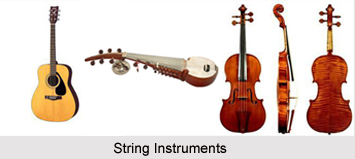 Indian musical instrument is as old as its musical tradition and culture. This fascination is passionately encased into the poetic and mythic imagination of the Indians and is reverberated amidst the fervour of folktales, fables, myths and legends. Indian musical instruments thus have a rich timeline. In fact when Lord Shiva as the epitome of the creator, destroyer and sustainers danced the Tandava then each pounding beat of his Damaru (the small drum Lord Shiva holds in His hand) alternated the forces of darkness and light. The terrible yet awe-inspiring, passionate yet fierce sound of the Damaru is said to be the origin of the concept of the musical instrument. Mythology asserts that Lord Shiva, the lord of dance, gifted humanity four instruments; the Veena, the Venu, the Damaru and the Mridanga. This indeed connotes that these might have been the primordial parent instruments. That was just the beginning of the journey of musical instruments in India as a devotional offering and accompaniment of music.
Indian musical instrument is as old as its musical tradition and culture. This fascination is passionately encased into the poetic and mythic imagination of the Indians and is reverberated amidst the fervour of folktales, fables, myths and legends. Indian musical instruments thus have a rich timeline. In fact when Lord Shiva as the epitome of the creator, destroyer and sustainers danced the Tandava then each pounding beat of his Damaru (the small drum Lord Shiva holds in His hand) alternated the forces of darkness and light. The terrible yet awe-inspiring, passionate yet fierce sound of the Damaru is said to be the origin of the concept of the musical instrument. Mythology asserts that Lord Shiva, the lord of dance, gifted humanity four instruments; the Veena, the Venu, the Damaru and the Mridanga. This indeed connotes that these might have been the primordial parent instruments. That was just the beginning of the journey of musical instruments in India as a devotional offering and accompaniment of music.Realistically a number of ancient Indian mural paintings, sculptures, literal and ancient theoretical works hold reference of the presence of the four primordial instruments like the Veena, Venu Mridanga and Damaru. With the passage of time, these Indian musical instruments underwent a thousand transformation and mutations and diversified into numerous other instruments. Regional as well as the geographical factors indeed contributed to the diversity of the tonal quality and in the variations in the designs of the Indian musical instruments. Many of the musical instruments seen today evolved in the medieval India owing to contacts with the Persian and Middle Eastern cultures. A number of musical instruments germinated as a result of the cultural fusion with the Islamic invasion in India. Rubab is one such musical instrument which came to India from Persia via Afghanistan during the time of early Islamic invasion and was indeed a part of the musical ensemble of the Mughal era.
With the advent of the colonial era, Indian musical instruments underwent a sea change. Instruments like the violin, the guitar, the mandolin, the clarinet and the saxophone were imported from the West and were largely absorbed in the philosophy of Indian music.
 Whatever be the origin, however deep may be the influence of society, culture, more and tradition in delineating the tone, form and designs of Indian musical instruments, in broader aspect Indian musical instruments can be classified into four main heads depending upon the sound they produce. Bharata muni in his Natyashastra also classified Indian musical instruments into four broad categories namely, the stringed instruments (tat or Tantra Vadya), the wind instruments (Sushira Vadya), the Ghana Vadya and the percussion instruments (Avanaddha Vadya). This mode of classification even survives today despite the introduction of newer musical instruments into the field.
Whatever be the origin, however deep may be the influence of society, culture, more and tradition in delineating the tone, form and designs of Indian musical instruments, in broader aspect Indian musical instruments can be classified into four main heads depending upon the sound they produce. Bharata muni in his Natyashastra also classified Indian musical instruments into four broad categories namely, the stringed instruments (tat or Tantra Vadya), the wind instruments (Sushira Vadya), the Ghana Vadya and the percussion instruments (Avanaddha Vadya). This mode of classification even survives today despite the introduction of newer musical instruments into the field.The string instruments are those which produce sounds when the strings are plucked with a finger or strapped, slapped or strummed. Indian musical instruments like the Rudra Veena, sitar, sarod and even Surbahar fall in this category. There is another category of stringed instrument like the violin, esraj, dilruba and the tar Shehnai, which make use of a bow to produce an uninterrupted series of notes.
For more visit the link below: